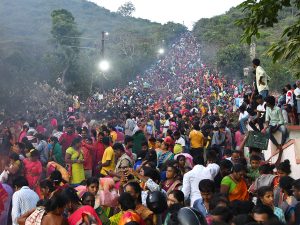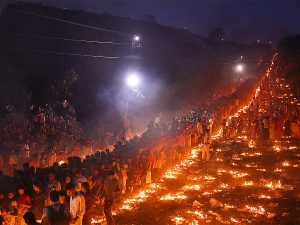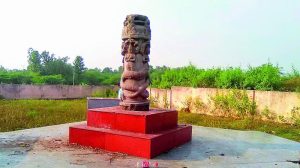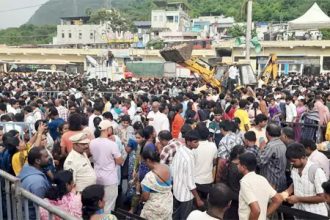Anantha Padmanabha Swamy Koti Deepotsavam 2025 – A Grand Festival of Lights and Devotion
The much-awaited Anantha Padmanabha Swamy Koti Deepotsavam is all set to be celebrated in grand style on the 19th of this month. Devotees from across Andhra Pradesh and neighboring states are eagerly preparing to witness this magnificent festival, which has become one of the most special spiritual events in the region. The Padmanabham Temple holds unique significance as it houses both Shaiva and Vaishnava shrines in close proximity—a rare feature in Hindu temple traditions. There are only two ancient temples dedicated to Anantha Padmanabha Swamy in India—one in Thiruvananthapuram, Kerala, and the other on the sacred Padmanabha Swamy Hill in Andhra Pradesh.
Every year, on the Kartika Bahula Amavasya (new moon day of the Kartika month), devotees perform the grand Deepotsavam, lighting countless lamps on the 1,286 steps leading up the Anantha Padmanabha hill. This breathtaking Koti Deepotsavam (Festival of a Million Lamps) is a tradition found nowhere else in the country, symbolizing the victory of light over darkness and devotion over ego. Thousands of devotees participate in this divine celebration, creating a mesmerizing spectacle of light and spirituality that radiates the eternal grace of Lord Anantha Padmanabha Swamy.

Padmanabha Swamy Koti Deepotsavam – The Grand Festival Marking the End of Kartika Masam
The Padmanabha Swamy Koti Deepotsavam is a sacred and vibrant festival celebrated at the end of the holy month of Kartika Masam. In the early hours of the morning, thousands of devotees climb the sacred hill of Anantha Padmanabha Swamy, anointing the steps with turmeric and saffron drops as part of their devotional ritual before having darshan of the Lord.
The celebration begins at the Kunthi Madhava Swamy Temple, located at the base of the hill, where the idol of Anantha Padmanabha Swamy is ceremoniously taken to the first pavancha (holy platform) amidst the chanting of powerful Vedic mantras and the sounds of auspicious traditional instruments. The deity is welcomed with a Purna Kalasha ritual, placed gracefully on the Garuda Vahana (divine eagle mount), and honored with special prayers.
As the rituals conclude, devotees receive darshan of Lord Padmanabha Swamy and immerse themselves in the divine aura of this spiritually uplifting festival. The Koti Deepotsavam symbolizes light, devotion, and the eternal presence of Lord Vishnu, attracting thousands of pilgrims from across Andhra Pradesh and beyond.
On Padmanabha Swamy Hill, devotees climb approximately 1,286 steps carrying lamps filled with oil, chanting the holy name of Lord Hari as they light the lamps. With the radiance of countless lights, the grand Anantha Padmanabha Swamy Deepotsavam shines resplendently. Devotees from various parts of the state, including the Uttarandhra districts, gather in large numbers to take part in this festival. Several voluntary organizations organize free food distribution and drinking water services. In addition, under the supervision of the Anantha Padmanabha Swamy Devasthanam authorities, various cultural programs are conducted.

How to Reach Padmanabham Temple
Devotees coming from Visakhapatnam (Vizag) can reach Padmanabham through Simhachalam – Anandapuram – Tagarapuvalasa route. From Simhachalam and Vizianagaram, Pallevelugu and Metro Express buses are available every ten minutes, making travel easy for pilgrims.
History of Padmanabham Temple
The present Padmanabham Temple is believed to have been built over the remains of an ancient shrine that existed before the 14th century — making it around 600 years old. The Pusapati royal family of Vizianagaram rebuilt this temple. It is also known as a “Swayambhu” (self-manifested) temple.
According to legend, during their exile, the Pandavas visited this hill and prayed to Lord Krishna to appear before them. Krishna told them that he would appear in an invisible form on this hill. Later, he manifested himself as symbols of Shankha (conch), Chakra (discus), and Namam (divine mark) on the rock, which the Pandavas worshipped. Over time, this divine form was covered by an anthill.
About 600 years ago, a Vizianagaram king from the Pusapati dynasty saw a snake in his dream. The Lord instructed him to discover the sacred spot covered by the snake pit and build a temple there. The king followed the divine direction and constructed the temple dedicated to Sri Ananta Padmanabha Swamy. According to local priests, even today a serpent is believed to roam around the temple premises as a symbol of divine presence.

History and Architecture of Padmanabham Temple
The Padmanabham Temple existed even before Emperor Sri Krishnadevaraya of the Vijayanagara (Kannada) Empire built his Victory Pillar (Vijaya Stambham) at the nearby village of Potnuru. During that time, the Pusapati royal family served as regional governors of this area, which was then under the control of the Kalinga Gajapati rulers. The Pusapatis continue to be the hereditary trustees of the temple even today.
The present temple complex was built on the remains of much older structures. Though it is difficult to identify the exact origins, some scholars believe the site dates back to the Eastern Ganga Dynasty period.
From its architectural features, it is evident that the current temple belongs to the late medieval period. However, the idol of Lord Padmanabha tells a different story. The concept of Padmanabha (Lord Vishnu reclining on the serpent Ananta) originated much before the medieval era, suggesting that the original shrine was far more ancient. Unfortunately, very few inscriptions remain today to narrate the temple’s true historical timeline.
Padmanabham War (Battle of Padmanabham):
After the death of Ananda Gajapathi Raju, Vijayarama Raju became the ruler of the Vizianagaram Zamindari. Once he took charge, the British authorities tried to increase the revenue payments (peshkash) from the Vizianagaram estate and also ordered him to reduce his army. They further demanded that he pay outstanding dues of ₹8,50,000.
Although Raja Vijayarama Raju proved that he had no such arrears, the British ignored his explanation and, on 2nd August 1793, they forcibly took possession of Vizianagaram.
This led to growing tensions between the Vizianagaram rulers and the British East India Company, ultimately resulting in the historic Battle of Padmanabham, a significant event in Andhra Pradesh’s regional history.
The British authorities ordered Raja Vijayarama Raju of Vizianagaram to move to Masulipatnam (Machilipatnam) and live there on a monthly pension of ₹1,200. However, Vijayarama Raju refused to obey these orders. Instead, he moved to Padmanabham, a village located between Bheemunipatnam (Bheemili) and Vizianagaram.
The Battle of Padmanabham took place on July 10, 1794. In this battle, the British forces faced the Vizianagaram army. Despite his courage, Vijayarama Raju and his men were not adequately equipped to fight against the British’s advanced weapons and artillery.
The war ended in tragedy — Raja Vijayarama Raju was killed in battle, along with around 800 of his soldiers. The defeat marked a major turning point in the history of Vizianagaram and established British control over the region.


